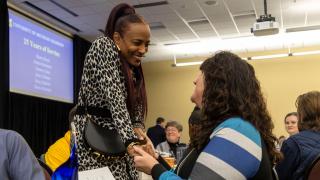

Josh Postel works on math problems in WeBWorK, a textbook-independent, open source, online homework system used by UM-Dearborn's math department.
The first day of class, Associate Professor Alan Wiggins told the students they could access their textbook online—and for free.
“There was a positive reaction from everyone,” said Postel, a math major. “The class’s previous textbook was $100 used. Most of us work part time at hourly jobs, so paying for that used textbook would be close to a week’s worth of work.”
Associate Professor Tom Fiore said faculty are concerned about the increasing amounts of college loan debt students are accumulating.
A recent White House report says more than 1.5 million Michigan residents have outstanding federal student loans, and cumulatively those people owe more than $40 billion—that’s approximately $26,500 per person.
Fiore says open-source educational resources (OER) could be an option to help alleviate some of the financial pressure, without sacrificing the quality of education.
Four math sections have already piloted open-source textbooks, which are books that have an open copyright license enabling educators to access the publication and to alter and distribute it without infringing on any copyright agreement.
Fiore says high quality PDF textbooks are freely available through the Open Textbook Initiative of the American Institute of Mathematics. The Editorial Board of the Initiative evaluates and approves the textbooks.
Fiore says abbreviated PDFs of open source textbooks are posted to the university’s Canvas learning management system for students who wish to professionally print a copy.
Another benefit to OER is that students can keep the materials after the class ends—unlike the traditional publishers’ eBooks, which are becoming a more popular economic choice.
“With an eBook rental, you pay $80 or $100 for short-term access. With an open-source book, you keep the PDF file forever. It doesn’t disappear,” Fiore said. “The format is changing for textbooks, from paper to electronic. But not being able to access the material after the class ends is a major problem, especially for people who want to go back years from now to reference it.”
But saving money isn’t the only reason Postel and his classmates were excited about the change. Other benefits included increased textbook accessibility, the option to print on-demand or “be green” and use less paper, and text searching.
“If you are looking for a definition, you can use keyword to search. Adobe also has great bookmarking tools,” Postel said. “I’ll be honest— at first it was a little difficult navigating it because not having a physical book was different. But once I got comfortable, I really liked it.”
And the digital textbook is a nice complement to WeBWorK, a textbook-independent, open source, online homework system that already is used by many faculty in the math department.
Just like the OER, WeBWorK is free to students and allows for faculty customization. Faculty can create their own math homework problems or use the national WeBWorK library, which has more than 20,000 problems available.
Assistant Professor Mahesh Agarwal, who pioneered the effort to bring WeBWorK to Dearborn in collaboration with UM-Ann Arbor in 2009, said the online system focuses on student success. It gives students immediate feedback on homework, increases access to professors, connects them to campus resources such as the Math Learning Center, and encourages students to fully understand the subject.
“WeBWorK exposes students to a variety of different mathematical approaches. So that when students finish a course, they will be familiar with a variety of different notations and ways to formulate a problem,” Agarwal said. “It is rigorous, so after using it, students have a better understanding of the material.”
Postel, who is also familiar with WeBWorK as both a student and a math mentor, said one of the benefits to an online platform is the conversation it facilitates in the classroom.
“From a learning perspective, it’s challenging. Because of that, we get to class early and, before class, we each share what we did when working to solve certain problems. I’ve never really done that until WeBWorK. It’s opened communication and created a more collaborative classroom environment,” Postel said.
Both Agarwal and Fiore also have found this to be true. In their December 2014 survey on student learning activities, the two professors learned more about the impact of WeBWorK on student collaboration.
When survey respondents were asked if they worked together with another student to practice, 61 percent of WeBWorK respondents said yes, while only 37 percent of non-WeBWorK students said yes.
Fiore and Agarwal said having a community available both online and in class is beneficial for both the students and the teachers.
“Customizing the books for class and then customizing the homework in WeBWorK creates classroom independence. It gives us, as teachers, a way to provide a more student-centered experience,” Fiore said.





